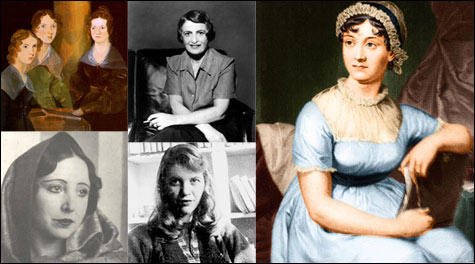
Clockwise from top left: The Brontës, Ayn Rand, Jane Austen, Sylvia Plath, Anaïs Nin
|
Can you remember the last time you curled up under the covers with Marcel Proust’s In Search of Lost Time? Have you ever had a snuggle session with a seven-volume, 3200-page tome about human consciousness? Me neither — thanks to the efforts of literary critics, core-curriculum revisionists, feminists, and post-modernists who’ve fought long and hard to effectively block mid-level Dead White Male authors from dominating traditional pedagogy. (Somewhere, Harold Bloom is praying for our uneducated souls.)
But I say leave the pasty old white dudes to their reign over the hallowed halls of the academe. Because, for every dozen Dead White Male authors being reanimated in a dingy basement by a bearded schnook in a sweater vest, there’s one quietly powerful Dead White Female author taking a meeting — and running Hollywood with a dainty iron fist.
Take Dead White Female author Jane Austen. She might still not be on every freshman English major’s first-semester required reading list, but her work has been heartily consumed by the entertainment industry: serious BBC adaptations, tongue-in-cheek contemporary reinterpretations, and, most recently, a glamorized pseudo-bio of Austen’s own life called Becoming Jane (in theaters now) that turns her into one of her own heroines. There are also Austen-themed tarot cards, blogs edited by devoted Janeites, fan fiction, musicals, even YouTube mash-ups that dub contemporary shows such as Gilmore Girls with Regency-era dialogue.
In taking a closer look at Austen and seven other broads, it’s clear that almost everything in contemporary pop culture can be traced to this Dead White Female author sisterhood. So move aside, please, kings of the Western canon — these ladies have got you by the balls.
Dead White Female Author: Jane Austen
BEST-KNOWN WORKPride and Prejudice, 1813 (“It is a truth universally acknowledged, that a single man in possession of a good fortune, must be in want of a wife.”)
POP-CULTURE LEGACY chick-lit; chick-flicks; Julia Roberts’s entire career
The best verbal catfight in Clueless is the one where Tai gets pissed at Cher for her dubious boy advice. “Why should I listen to you anyway,” Tai snaps, then lowers her voice an octave. “You’re a virgin who can’t drive.” Way harsh? OMG, totally. But swap the Valley Girl up-speak for a posh British accent and Tai and Cher become Emma Woodhouse and Harriet Smith, leading ladies of the classic coming-of-age tale Emma. Much like her 19th century model, Cher initially preferred matchmaking to indulging in romances of her own. When it comes to the modern-chick movement — which spans, roughly, from Julia Roberts in 1988’s Mystic Pizza to Julia Roberts in next year’s Friday Night Knitting Club — Austen has got the market cornered. An English minister’s daughter, one aspect of Austen’s genius was the ability to restrain her comic tone and sharp wit within the rigid social codes of the Regency era that framed her novels. No surprise, then, that the majority of fictionalized modern romances (When Harry Met Sally, You’ve Got Mail, Bridget Jones’s Diary) are rooted in her plots and character studies. One could well call Carrie Bradshaw and Hermione Granger updated revisions of Pride and Prejudice’s Elizabeth Bennet, a favorite protagonist of many Janeites. Like Elizabeth, they are somewhat prickly on the outside, then turn fond and tender when confronted with the possibility of true love. Even the now-defunct Jane (coincidence much?) magazine, and its predecessor, Sassy, were written to appeal to the girl who wasn’t afraid to be quirky — but could still get the guy in the end.